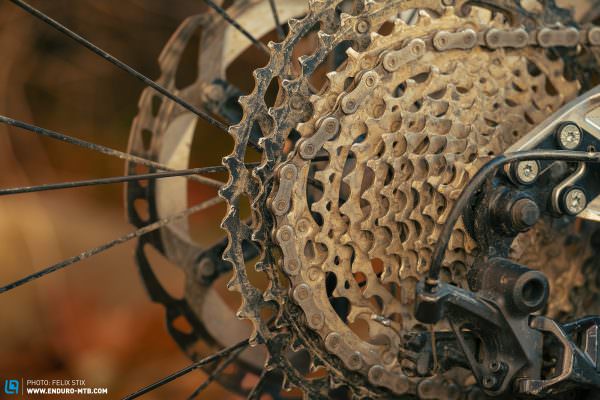Shimano XT M8100 12s drivetrain review – the almost perfect drivetrain
High-end drivetrains always work smoothly when new. That’s why we decided to take our time and test the Shimano XT drivetrain thoroughly over an extended period of time. How does it look after 14 months of constant abuse? Is our drivetrain worn out like an old hostel mattress or does it still perform well?

In typical Shimano style, the latest XT-range includes a wide selection of products, from drivetrain components to brakes – which we’ve already tested for you – all the way to chain links, which finally made it into Shimano’s portfolio. Particularly striking is the cool look of the rear derailleur and hollow alloy crank. The latter carries a few battle-scars but still works perfectly after 14 months – and we didn’t even bother using crank boots!
XTR, XT and SLX 12-speed drivetrains all offer very similar top-quality shifting performance. The main differences are in the weight and materials used. The shifters are different on the three groupsets and the XT model, for example, contains significantly more technology than the SLX version. The most striking upgrade from the SLX to the XT shifter is the Multi-Release function, which allows you to shift into harder gear – two gears at the time. While this feature might sound uninteresting at first, after getting used to it our test-rider Felix wouldn’t want to ride his Nicolai G1 without it. After short punchy climbs, for example, the Multi-Release of the new XT allows you to shift back into the right gear a lot faster. And those who have power in their legs will be able to transfer it to the trail more efficiently.

The XT shifter features Shimano’s Multi Release function, which allows you to shift down to gears at the time – which on the trail, this is a true godsend!
The 12-speed XT 10-51 cassette has a 510% gear range and – at 471 g – it’s also relatively light. This is made possible by the two largest sprockets, which are made of light alloy and are attached to an aluminium spider. Despite the softer material, the two big sprockets are still in very good shape after a year of abuse in all possible weather conditions. In order to accommodate the smallest sprocket on the freewheel, Shimano developed a new freewheel body called MICRO SPLINE. While at the beginning of this long-term test DT Swiss and Shimano were still the only brands to offer MicroSpline-compatible hubs, over the last year Shimano have loosened their licensing restrictions, allowing increasingly more brands to make their hubs compatible with the new MICRO SPLINE standard. The shift ramps of the cassette and chain are perfectly coordinated and thus allow for super-smooth and reliable shifting even under full load – no other system on the market beats the Hyperglide-technology in this regard!

Thanks to the sophisticated shift ramps on the cassette, the XT drivetrain implements gear shifts quickly and easily in both directions, even under full load. No other drivetrain shifts as smoothly.

As far as durability goes, the forged XT cranks are tougher than some of their expensive carbon counterparts. Even without using crank boots, our test-cranks are still running strong, even after 14 months of abuse.

The Shadow+ clutch mechanism, which can be easily adjusted via a practical tension-adjust port, prevents the chain from slapping on the chainstay. However, the mechanism is sensitive and high-maintenance.
While the chain, cranks, cassette and shifter of the Shimano XT drivetrain delivered a solid performance throughout the entire test-period, the rear-derailleur still shows some major teething problems. Apart from looking pretty cool, the XT rear-derailleur is incredibly robust, getting away pretty much unscathed from our 14-month long-term test – except for a few surface scratches. Even harder impacts, including a massive hit that caused the mech-hanger of Felix’s G1 to snap, left it pretty much unharmed. Apart from that, the derailleur is very easy to set up: a mark printed on the cage helps you find the optimal B-tension within seconds. A screwhead hidden under a rubber cover allows you to adjust the tension of the Shadow+ clutch, which effectively prevents the chain from slapping on the chainstays. Felix always runs his clutch at full tension and had to readjust this from time to time. Unfortunately, we’ve experienced some problems with the Shadow+ clutch mechanism – not only in this long-term test but also with several other test-bikes. The mechanism tends to lose tension over time, especially in the very first part of cage-rotation. Here, not even servicing and lubricating the clutch regularly helped. However, routine servicing of the clutch mechanism will help you prevent another frequent problem: if the bike doesn’t get used for a long time, the clutch seizes up and the cage gets stuck.
Shimano’s 12-speed XT drivetrain delivers outstanding shifting performance under load and strikes a great compromise between lightweight construction and affordable price. In addition, it offers great ergonomics, easy setup and the almost unique Multi Release function. Only the high-maintenance Shadow + clutch casts a dark shadow on an overall great impression. If you decide to run an XT rear-derailleur, we recommend buying a spare clutch straight away.
Tops
- Great shifting performance under load
- Easy Installation
- Multi Release mechanism
Flops
- Problems with the Shadow + Clutch
- Micro-spline freehub body required
Tester: Felix
Duration: 14 months
Price approx. € 670 (including cranks)
Weight cassette 471 g, rear derailleur 277 g, cranks 643 g, shifter 132 g, chain 255 g
More info at: bike.shimano.com
Did you enjoy this article? If so, we would be stoked if you decide to support us with a monthly contribution. By becoming a supporter of ENDURO, you will help secure a sustainable future for high-quality mountain bike journalism. Click here to learn more.
Words & Photos:








